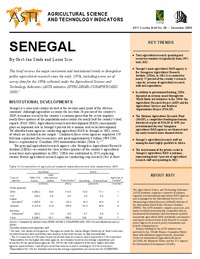Authors:
Stads, Gert-Jan; Sène, Louis
Year:
2004
Publisher
International Food Policy Research Institute (IFPRI); and Senegalese Agricultural Research Institute (ISRA)
Back to:
Agricultural R&D expenditures in Senegal have fallen gradually since the mid-1980s. The cause of this decline is threefold: nationalization of agricultural research resulted in large numbers of expatriate researchers being replaced with less expensive national staff, many researchers left the two government research agencies (ISRA and ITA) for more lucrative positions at international research agencies or in the private sector, and ITA increased its focus on non-research activities. During 1991– 2004, ISRA was strongly dependent on two consecutive projects: ARP-II, funded by a World Bank loan and counterpart funding from the Senegalese government, and PSAOP-I, funded by a World Bank loan, the national government, IFAD, and additional beneficiaries. These projects supported substantial institutional change at ISRA and greatly strengthened its financial and administrative management.
A significant component of PSAOP-I was the introduction of NARF, a competitive research fund that has transformed agricultural R&D financing in Senegal. All public and private agricultural R&D agencies compete equally for NARF funding, which has promoted demand-driven research and the rationalization of agency operations. In addition, further changes prevent donors from funding fixed research costs, and with the national government unable to fill this funding gap, both ISRA and ITA will need to further rationalize their operations and develop alternative sources of funding, such as internally generated funds through the sale of products and services. The planned second phase of PSAOP, scheduled to begin sometime after the conclusion of PSAOP-I (late 2004 to mid-2005), will likely reinforce the shift toward competitive financing mechanisms and restructuring of agency infrastructure to promote efficient, demand-driven, and farmer-focused research programs.
Despite these recent changes, Senegal’s agricultural research capacity remains strong compared with many countries in the region. Overall research investment (indicated by the country’s research intensity ratio) as well as average levels of spending per researcher remain well above the African average. In addition, Senegal’s agricultural researchers are among the most highly qualified in Africa. It will be important to ensure that this capacity is not eroded as Senegal’s agricultural research
agencies continue to respond to the changing funding environment.

